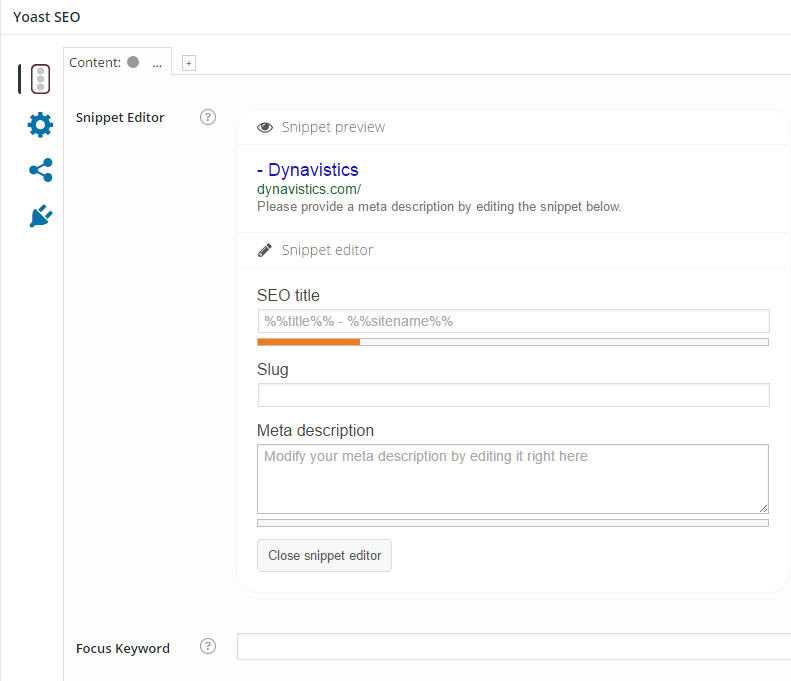
In part 1 of “6 Ways to Increase Your Website Conversion Rate,” I emphasized the importance of optimizing your homepage to make a lasting impression on your prospects, implementing calls-to-action (CTAs) to gain quality leads, and ultimately, not making your potential customers jump through hoops in order to make a purchase on your website. In part 2, I’ll cover 3 more critical components to improve your website conversion rate: search engine optimization (SEO), improving page content & load speed, and showing your credibility.
4) Search Engine Optimization (SEO)
SEO is not only a fundamental part of your online business strategy, but it is necessary for communicating to search engines and positioning your website to be found by potential customers who are in desperate need of a solution. First off, let me establish that I am not, nor do I claim to be, an SEO expert. But that’s the great news about SEO; you don’t need to be an expert to see some incredible results in your website. There are vast resources and tools available to you (for free) that can, with a little elbow grease, significantly improve your online rankings. The truth is, there are so many pieces to the SEO puzzle – so it is perfectly normal to feel overwhelmed at first. Instead of embarking on a long journey and analysis of each piece to the puzzle, I’m happy to share some tips and resources I’ve learned and leveraged that allowed me to see a 240% increase in website traffic within 6 months.
First Steps
If you are new to SEO or even consider yourself fairly knowledgeable, I’d highly recommend starting off by reading the Google Search Engine Optimization Starter Guide. This free guide covers the basics and even some semi-advanced tactics to increase your webpage rankings. Once you’ve finished the guide, you’ll have a better understanding of how SEO works, and you’ll most likely be hungry for more.
Google Webmasters
If you haven’t yet submitted your website sitemap to Google Webmasters, you’re missing out on some valuable information. Google Webmasters offers key insight into your website’s performance, including what your visitors are searching to find you, outside links to your site, and any crawl errors – all which are important to consider when managing your website and developing an effective SEO strategy.
Yoast SEO WordPress Plugin
WordPress users – you’re in luck. Perhaps the leading SEO plugin for WordPress, Yoast SEO handles the technical optimization of your site and significantly assists with improving your webpage rankings – for free. They have paid versions of the plugin, but the free version offers a robust set of features that assist and guide you to optimizing SEO for your pages.  Once installed, you can easily enter a title, meta description, and focus keyword for any post, page, media upload, etc. – all directly from the associated editor screen. And the plugin even rates your SEO strength and makes recommendations to improve your SEO once you’ve entered your information.
Once installed, you can easily enter a title, meta description, and focus keyword for any post, page, media upload, etc. – all directly from the associated editor screen. And the plugin even rates your SEO strength and makes recommendations to improve your SEO once you’ve entered your information.  Using the tools and recommendations provided by Yoast SEO, you’ll have a nice jump-start on your SEO strategy and performance, ultimately driving more traffic to your webpages and potentially increasing your conversions.
Using the tools and recommendations provided by Yoast SEO, you’ll have a nice jump-start on your SEO strategy and performance, ultimately driving more traffic to your webpages and potentially increasing your conversions.
Focus Keywords & Keyword Analysis
A lot of emphasis should be placed on the keywords you’re using in your content, especially for SEO. You’ll want to optimize your webpages with the right combinations of keywords to increase your chance of being found by prospects, depending on your business of course. But you might be wondering how you’re expected to know which keywords your potential customers are using in search engines? Sit back, relax, and enjoy the power of Google Keyword Planner.  This great tool provides insight into the monthly search volume of specific keywords. A good rule of thumb to follow, regarding choosing which focus keyword to use in your content, is finding a keyword with high monthly search volume and low competition. Below are a couple tips to consider when choosing the right keyword(s) for your webpages: 1) Use long-tail keywords: These keywords are 3 to 4 word phrases that are much easier to rank well for than generic single or double keyword phrases. Your chances of ranking well with generic keywords is extremely difficult against huge businesses with substantial marketing budgets. 2) No keyword stuffing: The old strategy of stuffing your specified focus keyword all throughout your webpage is now hurting your site more than helping with SEO. Instead, include your focus keyword a few times throughout your content, and use variations of your focus keyword elsewhere. Google’s crawl bots are smart, and they’ll know to recommend your page based off your keyword variations. 3) Use your keyword in the page title and URL: This is a fairly simple tip but you’d be surprised how often it is forgotten. Make sure your focus keyword is included in both of these locations to increase your SEO page rankings. Perhaps one of the most challenging truths about SEO is that search engine algorithms are constantly changing. Remember hearing about “Mobilegeddon” last year? It was Google’s new mobile-friendly ranking algorithm release that took the SEO world by storm. Basically, if your website wasn’t compatible for mobile devices, you could expect to see devastating effects in your search rankings and website traffic. And for those websites that had worked so hard to make it on the first page of Google search results while overlooking mobile compatibility, this was a tough pill to swallow. Moral of the story – make sure your website is mobile friendly. I haven’t even grazed all there is to know about SEO, but I wanted to share some tips and resources available to you if you want to see improvements in your webpage rankings. And remember, SEO is not a sprint; it’s a marathon. Analyze your website analytics, stay current on search engine algorithm changes, and continually increase your knowledge of SEO with the free resources available to you. In fact, you could very well find yourself on the 1st page of search results in the near future.
This great tool provides insight into the monthly search volume of specific keywords. A good rule of thumb to follow, regarding choosing which focus keyword to use in your content, is finding a keyword with high monthly search volume and low competition. Below are a couple tips to consider when choosing the right keyword(s) for your webpages: 1) Use long-tail keywords: These keywords are 3 to 4 word phrases that are much easier to rank well for than generic single or double keyword phrases. Your chances of ranking well with generic keywords is extremely difficult against huge businesses with substantial marketing budgets. 2) No keyword stuffing: The old strategy of stuffing your specified focus keyword all throughout your webpage is now hurting your site more than helping with SEO. Instead, include your focus keyword a few times throughout your content, and use variations of your focus keyword elsewhere. Google’s crawl bots are smart, and they’ll know to recommend your page based off your keyword variations. 3) Use your keyword in the page title and URL: This is a fairly simple tip but you’d be surprised how often it is forgotten. Make sure your focus keyword is included in both of these locations to increase your SEO page rankings. Perhaps one of the most challenging truths about SEO is that search engine algorithms are constantly changing. Remember hearing about “Mobilegeddon” last year? It was Google’s new mobile-friendly ranking algorithm release that took the SEO world by storm. Basically, if your website wasn’t compatible for mobile devices, you could expect to see devastating effects in your search rankings and website traffic. And for those websites that had worked so hard to make it on the first page of Google search results while overlooking mobile compatibility, this was a tough pill to swallow. Moral of the story – make sure your website is mobile friendly. I haven’t even grazed all there is to know about SEO, but I wanted to share some tips and resources available to you if you want to see improvements in your webpage rankings. And remember, SEO is not a sprint; it’s a marathon. Analyze your website analytics, stay current on search engine algorithm changes, and continually increase your knowledge of SEO with the free resources available to you. In fact, you could very well find yourself on the 1st page of search results in the near future.
5) Improving Page Content & Load Speed
Also an extremely important piece of the SEO puzzle, improving your webpage content and load speed is vital to keep your website visitors informed, engaged, and encouraged to come back to your website in the future. Approximately 75% of your website visitors will never return to your website if there first experience isn’t a pleasant one. Below are few things to consider to keep your website visitors coming back for more:
Know your market
Prior to just throwing some content together on a webpage, thorough market research is essential to determine the needs of your ideal customers. The more you’re aware of the pain points of your potential customers, the better you can craft your message to appeal to their needs and build a relationship. Develop rich & unique content, and focus on providing the best possible experience on your site.
Keep your webpages updated
Have you ever visited a website to discover that its last news or blog post was from several years ago? I certainly have, and my first impression of the business involved wondering if they were still in fact “in business.” Using your recent research of your market, find new informational, educational, and even fun content to offer to your visitors. And Google bots like new content, so this has a positive impact on your site’s SEO as well.
Use visually appealing page design & formatting
If your page content consists of long, overly extensive paragraphs – it’s time to make some changes. Think about the last time you quickly searched for an answer to a question. Let’s say you clicked on what appeared to be the right link to answer your question, and you land on a page that appears to be a college essay. Would you stick around, sifting through the content, to find what you’re looking for? Probably not. Use headings, bullet points, boldface font, italics and images to draw the eyes of your visitors to the important highlights of your content.
Monitor your page loading speed
Referring back to part 1 where we talk about the human attention span of coherent thought – if your pages take too long to load, your visitors may never even see you’re the content you’ve worked so hard to produce. PageSpeed Insights is a free tool to help you solve your page loading issues. After entering the URL of your page, your webpage will receive a grade (1-100) and recommendations to improve your load time. You’ll then have actionable insight into what is slowing your site down and how to solve it.
6) Show Your Credibility
Consumer reviews are more influential than ever before. In a recent Local Consumer Review Survey by BrightLocal, an incredible 88% of consumers say they trust online reviews as much as personal recommendations. Additionally, 72% of consumers agree that positive reviews make them trust a business more. So your potential customers are already developing a perception of the quality of your business before even making the first point of contact. This is an incredible opportunity for your business to build trust with potential customers, so a special emphasis should be placed on gaining customer reviews. Some of the most popular and effective methods for receiving reviews, aside from providing an exceptional experience for your customers, include social media promotion, offering discounts on the next visitor for completing a review, and following up with customers personally prior to a visit or sale. Add these reviews to your website, promote them through social media, and thank your customers for submitting their review. Make customer reviews a focus in your business, and expect to see a significant increase in website visits, conversions, and ultimately sales. However, B2B reviews are different than B2C and often much more difficult to obtain. I’ve come across many situations where customers are more than pleased with a product and/or service but neglect to complete a review, submit a testimonial, or agree to a case study. One of the most effective methods for receiving testimonials and content for case studies is to write the content yourself and ask for approval from your customer (of course). Receiving the stamp of approval on content you produced has a much higher success rate than asking customers to produce the content themselves. Just like consumers, businesses also judge other businesses on the clients they’ve worked with and the results they’ve provided for them. A great practice regarding B2B reviews is to offer an additional incentive to thank them for their endorsement (e.g. including their logo, website link and/or company description on your website). Show your credibility by featuring your customer reviews on your website, and reap the benefits of increased customer trust and loyalty. Have you had success with any of these strategies to improve your website conversion rate? I’d love to hear about it. Please leave a comment below!








